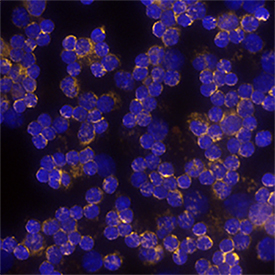Mouse BAFF/BLyS/TNFSF13B Biotinylated Antibody Summary
Ala127-Leu309
Accession # Q9WU72
Applications
Please Note: Optimal dilutions should be determined by each laboratory for each application. General Protocols are available in the Technical Information section on our website.
Scientific Data
 View Larger
View Larger
BAFF/BLyS/TNFSF13B in Mouse Splenocytes. BAFF/BLyS/TNFSF13B was detected in immersion fixed mouse splenocytes using Goat Anti-Mouse BAFF/BLyS/TNFSF13B Biotinylated Antigen Affinity-purified Polyclonal Antibody (Catalog # BAF2106) at 10 µg/mL for 3 hours at room temperature. Cells were stained using the NorthernLights™ 557-conjugated Streptavidin (red; Catalog # NL999) and counterstained with DAPI (blue). Specific staining was localized to cytoplasm.
Reconstitution Calculator
Preparation and Storage
- 12 months from date of receipt, -20 to -70 °C as supplied.
- 1 month, 2 to 8 °C under sterile conditions after reconstitution.
- 6 months, -20 to -70 °C under sterile conditions after reconstitution.
Background: BAFF/BLyS/TNFSF13B
BAFF (also known as TALL-1, BLyS, THANK) is a type II transmembrane glycoprotein belonging to the TNF superfamily and has been designated as TNF superfamily member 13B (TNFSF13B). Mouse BAFF is a 309 aa protein consisting of a 248 aa extracellular domain, a 21 aa transmembrane region and a 45 aa cytoplasmic tail (1, 2). BAFF has the typical structural characteristics of the TNF superfamily ligands. It is a homotrimeric protein having the structurally conserved motif known as TNF homology domain (3, 4). A higher ordered structure composed of a cluster of trimeric units resembling the structure of a viral capsid has also been reported (4). Mouse BAFF may be shed from the cell surface by proteolytic cleavage between R126 and Ala 127 to yield a soluble form of the protein detectable in serum (1, 5). Within the TNF superfamily BAFF shares the highest homology (48%) with APRIL (1). BAFF shares with APRIL the ability to bind to BCMA and TACI and also binds specifically to BAFF receptor (BAFF R, also known as BR3 or TNFSFR13C), which is the principal BAFF receptor (6‑8). All three receptors are type III transmembrane proteins that are expressed in B cells. BAFF and APRIL can form active heteromers that bind TACI (9). BAFF is expressed in peripheral blood mononuclear cells, in spleen and lymph nodes. Its expression in resting monocytes is upregulated by IFN-alpha, IFN-beta, LPS and IL-10. BAFF provides critical survival signals to a subset of B cells with intermediate maturation status (T2 B cells) during the immune response (10). BAFF also plays an important role in the development of lymphoid tissue and enhances the survival of activated memory B cells (7, 11). Human and mouse BAFF share 86% aa sequence identity (1).
- Schneider, P. et al. (1999) J. Exp. Med. 189:1747.
- Mukhopadhyay, A. et al. (1999) J. Biol. Chem. 274:15978.
- Karpusas, M. et al. (2002) J. Mol. Biol. 315:1145.
- Liu, Y. et al. (2002) Cell 108:383.
- Cheema, G.S. et al. (2001) Arthr. Rheum. 44:1313.
- Marsters, S.A. et al. (2000) Curr. Biol. 10:785.
- Thompson, J.S. et al. (2001) Science 293:2108.
- Ng, L. G. et al. (2004) J. Immunol. 173:807.
- Roschke, V. et al. (2002) J. Immunol. 169:4314.
- Batten, M. et al. (2000) J. Exp. Med. 192:1453.
- Avery, D.T. et al. (2003) J. Clin. Invest. 112:286.
Product Datasheets
Citations for Mouse BAFF/BLyS/TNFSF13B Biotinylated Antibody
R&D Systems personnel manually curate a database that contains references using R&D Systems products. The data collected includes not only links to publications in PubMed, but also provides information about sample types, species, and experimental conditions.
4
Citations: Showing 1 - 4
Filter your results:
Filter by:
-
Regulation of type 1 diabetes development and B-cell activation in nonobese diabetic mice by early life exposure to a diabetogenic environment
Authors: A De Riva, M Wållberg, F Ronchi, R Coulson, A Sage, L Thorne, I Goodfellow, KD McCoy, M Azuma, A Cooke, R Busch
PLoS ONE, 2017-08-03;12(8):e0181964.
Species: Mouse
Sample Types: Serum
Applications: ELISA Development (Detection) -
Interferon regulatory factor-5 deficiency ameliorates disease severity in the MRL/lpr mouse model of lupus in the absence of a mutation in DOCK2.
Authors: Yasuda K, Watkins A, Kochar G, Wilson G, Laskow B, Richez C, Bonegio R, Rifkin I
PLoS ONE, 2014-07-30;9(7):e103478.
Species: Mouse
Sample Types: Serum
Applications: ELISA Development (Detection) -
The sensing of environmental stimuli by follicular dendritic cells promotes immunoglobulin A generation in the gut.
Authors: Suzuki K, Maruya M, Kawamoto S
Immunity, 2010-07-23;33(1):71-83.
Species: Mouse
Sample Types: Whole Tissue
Applications: IHC-Fr -
Myeloid cells, BAFF, and IFN-gamma establish an inflammatory loop that exacerbates autoimmunity in Lyn-deficient mice.
Authors: Scapini P, Hu Y, Chu CL
J. Exp. Med., 2010-07-12;207(8):1757-73.
Species: Mouse
Sample Types: Serum
Applications: ELISA Development
FAQs
No product specific FAQs exist for this product, however you may
View all Antibody FAQsReviews for Mouse BAFF/BLyS/TNFSF13B Biotinylated Antibody
There are currently no reviews for this product. Be the first to review Mouse BAFF/BLyS/TNFSF13B Biotinylated Antibody and earn rewards!
Have you used Mouse BAFF/BLyS/TNFSF13B Biotinylated Antibody?
Submit a review and receive an Amazon gift card.
$25/€18/£15/$25CAN/¥75 Yuan/¥2500 Yen for a review with an image
$10/€7/£6/$10 CAD/¥70 Yuan/¥1110 Yen for a review without an image


